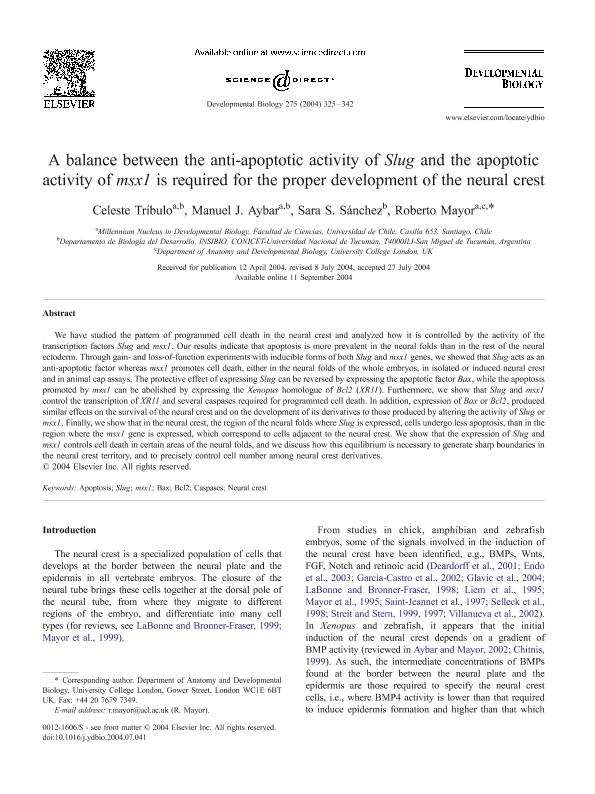Mostrar el registro sencillo del ítem
dc.contributor.author
Tríbulo, Celeste

dc.contributor.author
Aybar, Manuel Javier

dc.contributor.author
Sanchez, Sara Serafina del V.

dc.contributor.author
Mayor, Roberto
dc.date.available
2020-01-17T21:12:06Z
dc.date.issued
2004-11
dc.identifier.citation
Tríbulo, Celeste; Aybar, Manuel Javier; Sanchez, Sara Serafina del V.; Mayor, Roberto; A balance between the anti-apoptotic activity of Slug and the apoptotic activity of msx1 is required for the proper development of the neural crest; Academic Press Inc Elsevier Science; Developmental Biology; 275; 2; 11-2004; 325-342
dc.identifier.issn
0012-1606
dc.identifier.uri
http://hdl.handle.net/11336/95125
dc.description.abstract
We have studied the pattern of programmed cell death in the neural crest and analyzed how it is controlled by the activity of the transcription factors Slug and msx1. Our results indicate that apoptosis is more prevalent in the neural folds than in the rest of the neural ectoderm. Through gain- and loss-of-function experiments with inducible forms of both Slug and msx1 genes, we showed that Slug acts as an anti-apoptotic factor whereas msx1 promotes cell death, either in the neural folds of the whole embryos, in isolated or induced neural crest and in animal cap assays. The protective effect of expressing Slug can be reversed by expressing the apoptotic factor Bax, while the apoptosis promoted by msx1 can be abolished by expressing the Xenopus homologue of Bcl2 (XR11). Furthermore, we show that Slug and msx1 control the transcription of XR11 and several caspases required for programmed cell death. In addition, expression of Bax or Bcl2, produced similar effects on the survival of the neural crest and on the development of its derivatives to those produced by altering the activity of Slug or msx1. Finally, we show that in the neural crest, the region of the neural folds where Slug is expressed, cells undergo less apoptosis, than in the region where the msx1 gene is expressed, which correspond to cells adjacent to the neural crest. We show that the expression of Slug and msx1 controls cell death in certain areas of the neural folds, and we discuss how this equilibrium is necessary to generate sharp boundaries in the neural crest territory, and to precisely control cell number among neural crest derivatives.
dc.format
application/pdf
dc.language.iso
eng
dc.publisher
Academic Press Inc Elsevier Science

dc.rights
info:eu-repo/semantics/openAccess
dc.rights.uri
https://creativecommons.org/licenses/by-nc-sa/2.5/ar/
dc.subject
APOPTOSIS
dc.subject
BAX
dc.subject
BCL2
dc.subject
CASPASES
dc.subject
MSX1
dc.subject
NEURAL CREST
dc.subject
SLUG
dc.subject.classification
Biología Celular, Microbiología

dc.subject.classification
Ciencias Biológicas

dc.subject.classification
CIENCIAS NATURALES Y EXACTAS

dc.title
A balance between the anti-apoptotic activity of Slug and the apoptotic activity of msx1 is required for the proper development of the neural crest
dc.type
info:eu-repo/semantics/article
dc.type
info:ar-repo/semantics/artículo
dc.type
info:eu-repo/semantics/publishedVersion
dc.date.updated
2019-05-27T17:02:30Z
dc.journal.volume
275
dc.journal.number
2
dc.journal.pagination
325-342
dc.journal.pais
Estados Unidos

dc.description.fil
Fil: Tríbulo, Celeste. Consejo Nacional de Investigaciones Científicas y Técnicas. Centro Científico Tecnológico Conicet - Tucumán. Instituto Superior de Investigaciones Biológicas. Universidad Nacional de Tucumán. Instituto Superior de Investigaciones Biológicas; Argentina. Universidad de Chile; Chile
dc.description.fil
Fil: Aybar, Manuel Javier. Consejo Nacional de Investigaciones Científicas y Técnicas. Centro Científico Tecnológico Conicet - Tucumán. Instituto Superior de Investigaciones Biológicas. Universidad Nacional de Tucumán. Instituto Superior de Investigaciones Biológicas; Argentina. Universidad de Chile; Chile
dc.description.fil
Fil: Sanchez, Sara Serafina del V.. Consejo Nacional de Investigaciones Científicas y Técnicas. Centro Científico Tecnológico Conicet - Tucumán. Instituto Superior de Investigaciones Biológicas. Universidad Nacional de Tucumán. Instituto Superior de Investigaciones Biológicas; Argentina
dc.description.fil
Fil: Mayor, Roberto. Universidad de Chile; Chile. Colegio Universitario de Londres; Reino Unido
dc.journal.title
Developmental Biology

dc.relation.alternativeid
info:eu-repo/semantics/altIdentifier/url/https://www.sciencedirect.com/science/article/pii/S0012160604005482
dc.relation.alternativeid
info:eu-repo/semantics/altIdentifier/doi/https://doi.org/10.1016/j.ydbio.2004.07.041
Archivos asociados
